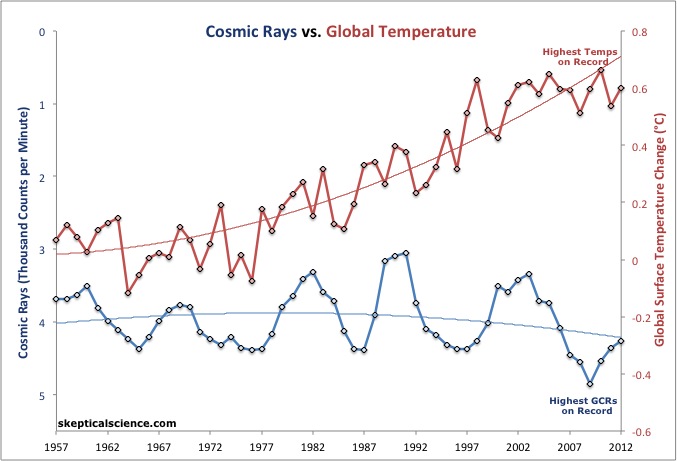
For climate skeptics trying to find an alternative explanation for the global warming that's occurred over the past century, the sun and galactic cosmic rays have become a popular hypothesis. However, several recent scientific papers have effectively put the final nail in the cosmic rays-global warming coffin.
Galactic cosmic rays are high energy particles originating from outside our solar system. Henrik Svensmark of the Danish National Space Institute is the main proponent of the hypothesis linking them to global climate change. The hypothesis goes like this:
1) Cosmic rays may be able to seed cloud formation.
2) If so, fewer cosmic rays reaching Earth means less cloud formation.
3) Fewer clouds reflecting sunlight means more solar radiation reaching the Earth's surface, and thus warming.
The sun's magnetic field deflects galactic cosmic rays, so if the sun is in a phase of high activity with a strong magnetic field, fewer cosmic rays will reach Earth. Hence if this hypothesis is correct, galactic cosmic rays will act to amplify the solar influence on the global climate, whether it be a cooling effect from low solar activity or warming from high solar activity.
This is a relatively new and interesting hypothesis, so it's become popular amongst climate contrarians as an alternative explanation to human-caused global warming. However, it's also been the subject of extensive scientific research over the past few years, and the hypothesis simply has not held up to scrutiny.
First, there's the obvious fact that cosmic rays cannot explain the recent global warming because solar activity and the amount of cosmic rays reaching the Earth's surface have remained flat on average over the past 60 years. The sun and cosmic rays could only be causing global warming if there were a long-term upward trend in solar activity and downward trend in cosmic rays reaching Earth. In fact, the number of cosmic rays reaching Earth has increased since 1990, and reached record levels in 2009 (one of the hottest years on record).
Annual average GCR counts per minute (blue - note that numbers decrease going up the left vertical axis, because lower GCRs should mean higher temperatures) from the Neutron Monitor Database vs. annual average global surface temperature (red, right vertical axis) from NOAA NCDC, both with second order polynomial fits.
A paper published in the journal Meteorology and Atmospheric Physics this August noted,
"Recent measurements of the cosmic ray intensity show that … even if cosmic rays enhanced cloud production, there would be a small global cooling, not warming."
Two of the authors of that paper (Sloan & Wolfendale) have also just published another cosmic ray research paper in Environmental Research Letters, finding that the contribution of solar activity and galactic cosmic rays (combined) to global warming is "less than 10% of the warming seen in the twentieth century."
Sloan & Wolfendale also examine the influence of cosmic rays on the climate over the past billion years in another new paper published in the journal New Astronomy. They find that changes in the galactic cosmic ray intensity are too small to account for significant climate changes on Earth. This was also the conclusion of a paper published this May in The Astrophysical Journal.
In another paper just recently published in Environmental Research Letters, Rasmus Benestad of The Norwegian Meteorological Institute compares measured changes in the amount of cosmic rays reaching Earth to changes in temperature, precipitation, and barometric pressure measurements. Benestad finds no statistical evidence that cosmic rays can explain the recent global warming.
Finally, a paper published last month in Geophysical Research Letters compared measurements of cosmic rays and cloud cover changes, and found no detectable connection between the two. This study is consistent with many previous papers finding that cosmic rays are not effective at seeding clouds. Likewise, in the CERN CLOUD experiments, Almeida et al. (2013) found
"ionising radiation such as the cosmic radiation that bombards the atmosphere from space has negligible influence on the formation rates of these particular aerosols [that form clouds]"
Thus every step in the galactic cosmic ray-climate hypothesis is fraught with problems. Evidence suggests that cosmic rays are not effective at seeding clouds. Solar activity has been flat, and even slightly downwards over the past few decades. Galactic cosmic ray flux on Earth has been flat, even slightly upwards over the past few decades. 2009, which saw a record number of cosmic rays reaching Earth (meaning it should have been cold), was the 5th-hottest year on record at the time.
This failed hypothesis offers a stark contrast to the overwhelming consensus that our greenhouse gas emissions are driving warming. The latter is supported by solid, well-understood fundamental physics. We know that increasing the greenhouse effect causes more energy to be trapped on Earth, and that energy has to go somewhere. The observed pattern of warming is precisely what we expect to see from an increased greenhouse effect, for example with the 'fingerprint' of a cooling upper atmosphere due to more heat being trapped in the lower atmosphere.
Note: this post has been incorporated into the Advanced rebuttal to the myth "it's cosmic rays"
Posted by dana1981 on Tuesday, 12 November, 2013
 |
The Skeptical Science website by Skeptical Science is licensed under a Creative Commons Attribution 3.0 Unported License. |